Reeperbahn
The Reeperbahn (German: [ˈʁeːpɐˌbaːn] (![]()
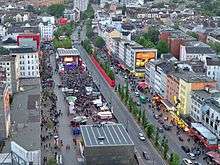 Reeperbahn (right) passing Spielbudenplatz | |
| Length | 930 m |
|---|---|
| Location | St. Pauli, Hamburg, Germany |
| Postal code | 20359, 22767[1] |
| Nearest metro station | |
| Coordinates | 53°32′58″N 9°57′44″E |
| Millerntor end | Millerntorplatz |
| Major junctions | Davidstraße, Große Freiheit |
| Nobistor end | Holstenstraße |
| Other | |
| Known for | night life, prostitution |
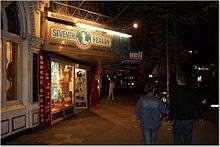
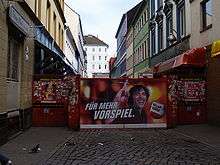
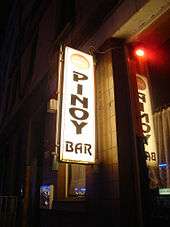
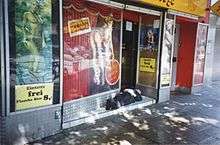
Name and history
The name Reeperbahn means ropewalk, which is a place where ropes are made (Low German Reep = rope, the standard German word is Seil; Bahn = track). Until the 1620s Hamburg's ropewalks had been located in the Neustadt (New Town) quarter of the inner city close to the Elbe, which then became a densely built up area. Therefore, the ropewalks "had to be relocated outside the city walls on the country road leading toward Altona – which later took on the street name 'Reperbahn'."[2] The street was a ropewalk in the 17th and 18th centuries.
The street and its side streets
The street is lined with restaurants, night clubs, discotheques and bars. There are also strip clubs, sex shops, brothels and similar businesses. Between 1997 and 2007 the Erotic Art Museum was open on Nobistor, a street running between the Reeperbahn and Louise-Schroeder-Straße.
The Operettenhaus, a musical theatre, is also located at the Reeperbahn. It played Andrew Lloyd Webber's Cats for many years, after that Mamma Mia!, an ABBA-musical, followed by "Ich war noch niemals in New York", ("I have never been to New York") featuring hit songs by Austrian singer/songwriter Udo Jürgens, then Sister Act and finally Rocky, based on the Stallone film. There are other theatres at the Reeperbahn (St. Pauli Theater, Imperial Theater, Schmidt's Tivoli) and also several Cabarets/Varietés.
A famous landmark is the Davidwache, a police station located on the South side of the Reeperbahn at the cross street Davidstraße. Street prostitution is legal during certain times of the day on Davidstraße. The Herbertstraße, a short side street off the Davidstraße, has sex workers displaying themselves behind windows, waiting for customers. Since 1933, large screens block the view into Herbertstraße from the adjacent streets. Since the 1970s, there have been signs saying that entrance to the street is prohibited for women and juveniles; however, it is a public road which anyone may enter. Many pubs, and street-based sex workers, can be found on the square of Hans-Albers-Platz south of the Reeperbahn.
The Große Freiheit ("Great Freedom") is a cross street on the North Side with several bars, clubs and a Catholic church. In former years, several sex theatres here (Salambo, Regina, Colibri, Safari) would show live sex acts on stage. As of 2007, until its closure in 2013, the Safari was the only live sex theatre left in Germany.[3][4] The popular table dance club Dollhouse now takes the place of the Salambo. Hotel Luxor, Hamburg's oldest brothel that had operated on this street for 60 years, was closed in 2008.[3] The street's name comes from the fact that Catholics were allowed to practise their religion here at a time when this district did not yet belong to Hamburg; they were forbidden from doing so in Protestant Hamburg proper.
In 1967, Europe's largest brothel at the time, the six-floor Eros Center, was opened on the Reeperbahn. It was closed in the late 1980s amidst the AIDS scare.[5][6]
At a major trial during 2006 and 2007 ten members of the "Marek Gang", which controls brothels on and near the Reeperbahn, were charged with pimping. The judge rejected the charge of forming a criminal gang and handed out suspended sentences: the men had started relationships with young women in local discotheques in order to recruit them to work in their brothels, an illegal practice if the women are under 21 years of age; some men had also abused some of the women who worked for them.[7]
Because of the problems with the high crime rate, in 2007 the Senate of Hamburg enacted a ban on weapons in the Reeperbahn area. The only other such area with a weapons ban in Hamburg is the Hansaplatz, St. Georg.[8]
The St Pauli Preservation Society decries the ongoing gentrification of the area. Several old-timers blamed the decline of the Reeperbahn's sex industry on the rise of discotheques and cheap bars that attract teenage customers.[3] In 2013, the Dancing Towers were built at the eastern end of Reeperbahn, symbolizing a couple dancing tango. The increasing number of these and other modern buildings erected at the Reeperbahn attracted criticism by some St. Pauli inhabitants.[9][10]
The Beatles
In the early 1960s, The Beatles (who had not yet become world-famous) played in several clubs around the Reeperbahn, including the Star-Club, Kaiserkeller, Top Ten (Reeperbahn 136) and Indra. Stories about the band's residencies, onstage and offstage antics are legendary; some stories are true (John Lennon played a song set with a toilet seat around his neck), others inflated (the band urinating in an alley as nuns walked past was told rather differently later). A fellow musician, Ted "Kingsize" Taylor, made a crude tape recording of their last New Year's Eve show, at the Star-Club in December 1962; a cleaned-up version of the tape was later released as an album, later characterized by Harrison as "awful".
Famously John Lennon is quoted: "I might have been born in Liverpool – but I grew up in Hamburg".[11]
In memory of this time a Beatles-Platz was built at the cross of Reeperbahn and Große Freiheit.[12]
Popular culture
%2C_Hamburg%2C_Germany_4.jpg)
The popular 1944 movie Große Freiheit Nr. 7 tells the story of a singer (played by Hans Albers) who works in a Reeperbahn club and falls in love with a girl played by Ilse Werner. Hans Albers and Heinz Rühmann played in the 1954 movie Auf der Reeperbahn nachts um halb eins (On the Reeperbahn at Half Past Midnight, after a song of the same name sung by Albers in the 1944 film).
In 1958, Trinidadian calypso artiste, Lord Invader recorded a track entitled "My Experience On The Reeperbahn". It recalls a time when he was conned by a transvestite. "You cannot tell a man from a woman. I was a man dancing hand in hand with a man dressed as woman on the Reeperbahn". "Reeperbahn" is a 1978 song by Udo Lindenberg, to the tune of Penny Lane, lamenting the decay of the entertainment there.
In the 1965 film Ship of Fools, Jose Ferrer and Christiane Schmidtmer sang "Heute Abend Geh'n Wir Bummeln Auf Der Reeperbahn." (Tonight We Will Go Strolling on The Reeperbahn)
The Police song "Low Life" is about the Reeperbahn.
Randy Pie 1975 song "Kitsch" is about a curiosity shop on the Reeperbahn – the group hailed from Hamburg.
Reeperbahn is the name of a 1980s Swedish band. Finnish artist Irwin Goodman has made a song and an album called St.Pauli ja Reeperbahn. The street is also mentioned in the Elvis Costello song "Human Hands", in Van Morrison's song "Heavy Connection", in Paul Kelly's song "Every Fucking City", in the Midnight Oil song "Mountains of Burma", the Sloppy Seconds song "Germany" from their album Destroyed and in the Runrig song "Song of the Earth". The heavy metal band Blue Cheer have a song called "Sweet Child of the Reeperbahn" on their 1991 album Dining with the Sharks. The punk band The Toy Dolls have a song titled "Caught up the Reeperbahn", first released on their 1993 album Absurd-Ditties.
"Reeperbahn" is the name of a track from the Christian rock group Model Engine's CD The Lean Years Tradition.
The Reeperbahn is often mentioned in Karen Duve's 1999 novel, Regenroman. (The English translation is entitled Rain).
Tom Waits' 2002 release Alice contains a track called "Reeperbahn".
Dutch DJ and producer Nicky Romero had the music video for his song "Toulouse" shot in Hamburg, Germany. Near the end, the actors enter the Reeperbahn's subway system.
Australian pop-punk band the Hard-Ons have a song called "Don't Fear The Reeperbahn" on their 2007 album Most People Are Nicer Than Us. Its title is a play on the Blue Öyster Cult song "(Don't Fear) The Reaper".
German electro house duo Digitalism recorded the song "Reeperbahn" on their 2011 release I Love You Dude.
The commercial house music producer Eric Prydz has a track titled "Reeperbahn" under his moniker Pryda.
London based indie band Spector have a bonus track titled "Reeperbahn" on the deluxe version of their 2015 album Moth Boys.
UK based folk rock band Skinny Lister wrote a song titled Hamburg Drunk, which depicts a rough night "falling and sprawlling down the old Reeperbahn" on their 2016 album "The Devil, The Heart and the Fight".
See also
References
- Staff (2008). Straßen- und Gebietsverzeichnis der Freien und Hansestadt Hamburg 2008 (Hamburg list of streets and locations) (in German). Hamburg: Statistical office Hamburg and Schleswig-Holstein (Statistisches Amt für Hamburg und Schleswig-Holstein). ISSN 0938-636X.
- Rainer Postel, "Hamburg at the Time of the Peace of Westphalia", in: 1648, War and Peace in Europe: 3 vols., Klaus Bussmann and Heinz Schilling (eds.), Münster in Westphalia: Veranstaltungsgesellschaft 350 Jahre Westfälischer Friede, 1998, (=Catalogue for the exhibition «1648: War and Peace in Europe» 24 October 1998 – 17 January 1999 in Münster in Westphalia and Osnabrück), vol. 1: Politics, Religion, Law, and Society, pp. 337–343, here p. 340. ISBN 3-88789-128-7.
- Death of the Reeperbahn: Hamburg's streets of shame, The Independent, 21 March 2008
- Schaefer, Daniel (2014-02-05). "Kiezclub Safari schließt nach 50 Jahren seine Türen".
- A Red-Light District Loses Its Allure, The New York Times, 14 May 1988
- Willi Bartels ist tot, Spiegel Online, 5 November 2007. (in German)
- Freiheit für die Bordell-Bosse, Spiegel Online, 19 April 2007. (in German)
- Ban of weapons in Hamburg press release police Hamburg (in German)
- Jetzt kommen Teheranis "Tanzende Türme" an die Reeperbahn, Hamburger Abendblatt, in German
- Club in den Niederungen, Süddeutsche Zeitung, in German
- Hillman, Bill. "Beatle Echoes On the Reeperbahn (Quotations taken from The Beatles Anthology)". Hillmanweb. Retrieved 2009-05-15.
- Spatensich für Beatles-Platz Archived 2009-02-12 at the Wayback Machine bild.de (in German) Retrieved on June 19, 2008
External links
![]()
- Information about Reeperbahn and the St. Pauli district (in English)
- - links and information about the reeperbahn (in German)
- - the night life in Hamburg on the Reeperbahn (in German)
- Picture from the Reeperbahn (in German)
- St. Pauli and the Reeperbahn (in English)